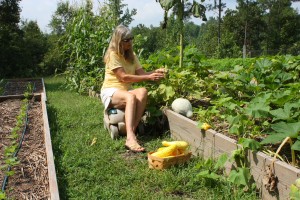Notice this is not “What We’ve Learned.” Growing squash – particularly after the first year you grow it – is a great antidote for the bighead.
Our first year of squash, like those of so many others, was all success, with prolific blossoms and prolific fruit from nearly everything we planted. We were quite proud of ourselves, but each year we’ve discovered some new way Mother Nature has devised to torment our squash and us hapless souls trying to grow it. This week we offer some perspective on squash formed over our five years of planting it, nurturing it, watching it die, and every now and then, enjoying its delicious bounty.
Listen – 21:09

Amanda is checking the trap-crop squash in Bed #7. That big globe close to her knee is a blue hubbard. And no, we don’t yet know how it will taste. The “tree” in front of her and to her left is a sunflower that towers over Veg Hill. Just behind her in Bed #3 is her edamame. And over her right shoulder is the Three Sisters (corn, beans, and squash) bed.
Here’s the information from Southern Exposure Amanda was summarizing about squash varieties that are resistant to squash vine borers:
In its seed catalogue, Southern Exposure indicates four species of squash with varying susceptibility to vine borers. C. pepo and C. maxima species are susceptible to vine borers, whereas C. mochata and C. argyrosperma (C. mixta) have good resistance to vine borers and cucumber beetles. Unfortunately, yellow squash, zucchini, and Big Max pumpkin are all in the susceptible category.
Recommended:
- Butternut
- Trombocino
- Tan Cheese pumpkin
- Green-striped Cushaw